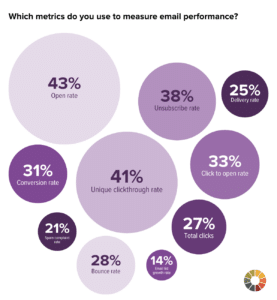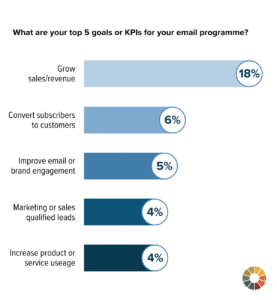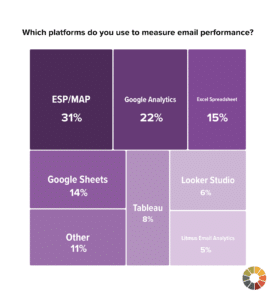Email Analytics: How to Measure Email Marketing Success Beyond Open Rate
Email analytics used to focus on open rate as the gateway to email marketing success.
After all, you can’t get a conversion without someone first opening your email.
If we’re being honest, though, email open rates have always been a bit of a vanity metric. (Yup, we said the quiet part out loud.)
What makes a high-performing email program successful isn’t about how many emails get opened, but how much revenue it generates. That’s why we spend hours and hours geeking out about optimizing email for mobile or crafting the perfect subject line—because our email marketing efforts need to impact an organization’s bottom line.
When you know which email analytics to measure, how to calculate performance, and how to explain what it means to decision-makers, you’re empowering yourself and your team to take charge of your marketing strategy.
Here’s how you can measure the success of your email marketing campaigns beyond open rate:
Open rate is no longer a reliable email marketing metric
Open rates haven’t been the same since Apple’s Mail Privacy Protection (MPP) came into effect in the fall of 2021.
This hides subscriber IP addresses from senders, so it’s impossible to link online activity with a specific subscriber or see their location—and whether or not they opened your email, which artificially inflates your numbers.
“Apple’s Mail Privacy Protection blocks email marketers from seeing whether or not someone has actually opened an email, or having any detailed information about that subscriber and how they engage,” says Jess Materna, Director of Product and Partner Marketing here at Litmus. “Open rate has become a challenging metric to look at on its own, because the data just isn’t there.”
If any other mailbox provider implemented something like this, it would be challenging, but not impossible. But Apple Mail is consistently one of the top email clients by market share. As of March 2024, MPP accounts for 55% of all opens. That means more than half are obscured by MPP, making open rates a pretty lousy metric for determining whether or not you’re doing a good job.
Due to this development, open rate is just an unreliable number to measure. There is some small value in tracking open rate in that a sudden drop in open rate could be a sign of poor email health. But overall, open rates month-over-month and year-over-year don’t provide any insight into the actual success of your email marketing program.
Yet according to data from our recent State of Email Innovations survey, 40% of email marketers still turn to email open rates as a primary measurement of their success. 😱

It’s time for email marketers to go beyond open rates to measure their success.
Why your email marketing metrics should reflect your goals
Every email you send should have a purpose in your email marketing strategy. As you think about how to measure email marketing success moving forward, consider your “why.”
For most email marketers, the goal isn’t only to get the recipient to open an email.
When we asked email geeks what their primary goals and KPIs were for their email program, the answer didn’t surprise us: Revenue. 💰

When you think about measuring your email marketing performance, you need to start with your goals. Email can do all of the above—it’s up to you to decide what’s most important to your business.
If you want to improve email engagement (the third most popular response), brainstorm creative email elements that encourage clicks and true human activity. For example, a simple thumbs up or thumbs down button can help capture some more insight about your subscriber preferences, and gauge whether they are active. Interactive elements invite participation— and thus, engagement— in your emails. We provide some more dynamic email content examples here.
If the goal is converting subscribers to customers (coming in at the fourth most popular goal), test different ways of delivering a conversion event. Consider the big picture. How does email feed into your other touchpoints? Look at your subscribers through a lens that is bigger than recipients of email.
Bottom line: if revenue is what you’re after, then don’t waste your time measuring open rate.
Focus on these email marketing analytics instead
Email has been one of the most effective and popular marketing channels for what feels like forever, but the way it slots into the different phases of the customer journey is new. Email is the relationship-builder—it gives subscribers a way to get to know your brand more deeply so they trust you enough to buy from you.
“A lot of people take open rate as the most important thing to look at, but it’s not the only metric you should care about,” says Paxton Nicholas, Email Operations Analyst at Klaviyo. “You should also be looking at other human signals to see how you’re performing and engaging with you.”
This includes email marketing analytics like:
2. Click-through rate (CTR)
Click-through rate is a classic email marketing metric that shows how many of your delivered emails were clicked on by a subscriber.
Click-through rate = (number of emails clicked / number of emails delivered) x 100
Some marketers prefer click to open rate (CTOR) instead, which measures the number of opened emails clicked instead of the number of emails. But with open rates being trickier to nail down, it may be better to leave them out of the equation.
2. Conversion rate
CTR is one thing, but it doesn’t actually tell you if a subscriber followed through on their click. Conversion rate, instead, looks at how many people took action based on your email. A conversion depends on the email—it can refer to a purchase, webinar sign-up, ebook download, or reply.
Conversion rate = (number of conversions / number of emails delivered) x 100
You can calculate your conversions by looking directly at clicks from a given campaign or pull together multiple data sources to understand the broader conversion path from email to website or from email to sales meeting.
3. Unsubscribe rate
The unsubscribe rate, also known as opt-out rate, measures how many people choose to stop receiving your emails.
Unsubscribe rate = (number of unsubscribes / number of emails delivered) x 100
Email marketers love to hate on unsubscribes, but knowing your unsubscribe rate is a great piece of feedback for how well you’re matching your email campaigns to your subscriber preferences. Try not to worry too much about it—it’s much better to let unsubscribes go than to get marked as spam later.
“With Gmail and Yahoo’s new deliverability rules where you must implement a one-click list-unsubscribe, monitoring your unsubscribe rate is important to determine your overall engagement.”
4. Revenue per email (RPE)
Revenue per email shows you exactly how much money a single email campaign made by looking at the number of emails sent vs. your revenue attributed to that campaign.
Revenue per email = revenue generated / number of emails delivered
Giving a direct monetary value to your emails allows you to better understand how you’re driving sales for your business, but it can also help you draw a distinction between the types of campaigns you send and how they impact your business. You don’t want to overdo the more sales-y emails, but you also need to hit your numbers. If you know on average how much revenue a single campaign can bring, you can more accurately forecast your performance.
6. Subscriber lifetime value (LTV)
Growing your email list is one of the most important tasks for an email marketing team that doesn’t revolve around the email production cycle. But not every subscriber is created equal.
Subscriber lifetime value measures how much revenue a subscriber brings to your business throughout their time on your list. It’s a little trickier to calculate than some of the other metrics on this list, but it’s worth knowing against your acquisition cost.
Subscriber lifetime value = monthly revenue per subscriber x average number of months a subscriber stays on your list
A good way to use this metric is when considering whether or not an email is worth sending based on the value of subscribers I can expect to lose from unsubscribing vs. the value I get from sending the email.
7. Return on investment (ROI)
Your email marketing return on investment (ROI) measures the value your program delivers against how much it costs to run.
ROI = (email revenue – email marketing cost) / email marketing cost
To calculate your ROI, you’ll need to gather up every line item in your budget, from subscriptions to tools like your ESP to your team’s salaries. It may seem like the costs keep piling up, but the average ROI is a whopping 36:1. Showing this in real terms to your leadership team may be what helps you get more buy-in for experimental campaigns (or at least a little more help!).
For a full list of even more email marketing analytics worth exploring, check out this article.
Think about how you measure email marketing metrics differently
There’s a common saying in the analytics world: What gets measured gets managed.
Part of the reason email marketers love to focus on open rates? They’re easy to understand and easy to see right in your ESP.
When we asked email marketers what tools they used to measure their performance, the majority of respondents use their built-in ESP tools, which often focus on metrics like opens, clicks, and unsubscribes—the stuff that we can control.

That’s probably why so few email marketers told us they measured important conversion metrics like return on investment (ROI). And why 72% of respondents don’t actually know what the ROI of email marketing is, despite citing it as the most used and most effective marketing channel in their overall strategy.

Data points like ROI and subscriber lifetime value are incredibly useful to calculate, but require multiple sources of data to figure out (and let’s be real, a data analyst who knows their way around more advanced platforms like Tableau.)
Can email achieve more than just revenue numbers? Of course. You don’t want to get hung up only on selling to your subscribers—they’ll tire of you pretty quickly.
But taking the time to attribute your pipeline to email not only validates your current email strategy and investments, but it also gives you a much stronger indication of whether or not your email tactics actually work.
Understand email analytics in the modern marketing era
You can’t afford to guess what’s working and what’s not with your email marketing efforts.
Pivoting your strategy for how to measure email marketing success is an opportunity to learn more about your subscribers and introduce your own leadership to new ways of thinking about email results.
Investing in the right email analytics to understand your team’s success is paramount as consumers, email services, and other entities outside our control evolve. Email marketing teams must move with the changing tides, and upgrading your target email analytics is a great place to start.

Kayla Voigt
Kayla Voigt is a freelance writer
